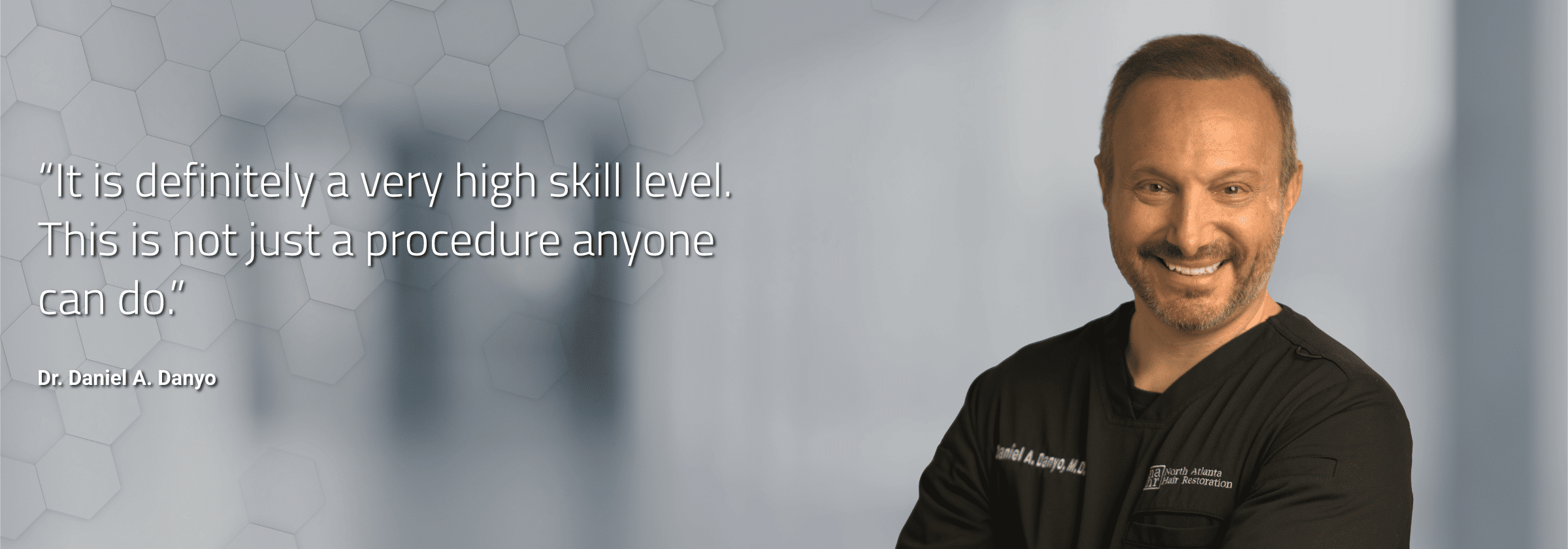In this episode, Dr. Danyo discusses the differences between shaved and Shave-less hair restoration techniques, and the skills required to do them effectively. He also talks about the dangers of seeking out black-market procedures and the importance of researching providers ahead of time.
Boiling Down the Difference Between Shaved and Shave-less FUE Restorations
Dr. Danyo offers an analogy for golfers: The shaved case is like when your ball is on the fairway and you just go up and hit it; a Shave-less case is like when your ball is in the rough and you have to go out there and find it.
When you have an unshaved case, the landscape is very different. It takes a lot of practice and experience to know what to do.

First, What is FUE?
FUE stands for Follicular Unit Excision, formerly known as Follicular Unit Extraction.
It is a surgery where hair follicles are removed and then replaced elsewhere on the head, but unlike an older procedure known as FUT, there’s no linear scar.
Because FUE takes random hairs from the scalp, you don’t get that visible line people used to get with older restorations.
The technology is so much better and more advanced now, so you can get a natural look without the stigma of looking like you had a hair transplant.
FUE is very difficult to do, there are many challenges that are unique to each transplant, so you need to get pristine grafts, uninjured grafts that actually take and grow hair once they’re moved.
It is important to find a doctor who has worked on all skin types, all hair types and different types of cases, or you’re not going to get the results you’re looking for.
Dr. Danyo has done over 4 million grafts on patients of all types, including African Americans, whose hair and skin types present their own specific challenges.
He’s worked on hard cases with great success, too. They used to say that FUE wasn’t appropriate for every patient because it’s so delicate and precise, but the doctor has shown that that doesn’t have to be the case.
The doctor points out that there’s a lot of bad work being done in FUE hair restoration, so you need to do your research and make sure it’s an actual physician doing your surgery—because this is surgery, no doubt about it.
You see so many ads, billboards, etc. about hair restoration, but in a lot of cases it’s not the doctor doing the procedure. Be sure to ask a lot of questions and get the right answers.
Don’t just pick someone off the internet and hope for the best.
That brings us to another issue: there’s also a dark side to the hair restoration industry, and that’s black market procedures.
The Dangers of Seeking Out Black Market Procedures
The International Society of Hair Restoration Surgery (ISHRS) has a consumer awareness campaign to alert people to the dangers of black market hair restorations.
Essentially, there are unlicensed technicians who should not be performing these procedures who are doing so anyway.
This often results in botched procedures that can cause scarring, injury and even more hair loss for those seeking hair restoration.
What’s more, many states don’t have laws stating that a doctor should be doing all excisions and incisions for the placement of grafts.
Even laser hair removal specialists and acupuncturists are more regulated in Georgia than hair restoration practices.
So it’s up to the consumer in states like Georgia to ensure it is a physician performing their hair restoration surgery.
Now that we know a bit about these procedures and what to avoid, let’s get back to a question that many people have about hair restoration:
Do I Need to Have a Shaved Head to Get a Hair Transplant?
No, you do not need to have any part of your head shaved to have a transplant.
Now, the technique for Shave-less FUE is more complicated than a shaved case.
Here’s how it works at NAHR:
Dr. Danyo makes a round incision to extract the follicles from the donor site, then the technician team assisting him will sort and store these ahead of their placement into the new, transplanted position.
They cut and core each follicle as they go, and they have a streamlined approach and high-tech equipment that makes the process fast, safe and highly effective.
They can also do long hair transplants, where they move the whole hair without trimming it for a more natural look off the bat.
70% of the doctor’s restorations on men are Shave-less transplants, and almost all of the ones done on women are Shave-less, as well.
So, What’s the Advantage of These Shave-less FUE Procedures Over Shaved Ones?
Well, you walk out looking much like you did when you came in, and when it’s done right, the donor site doesn’t look different either.
There’s a real concern for patients that the back of the head will “look weird” or the hair there will be too thin after harvesting follicles from it, but Dr. Danyo knows what he’s doing and has years of experience with these types of transplants.
Unlike at some hair restoration practices, Dr. Danyo is very careful not to overharvest at the donor site, and he is careful to preserve the viability of the follicles he extracts.
That means that more hair can grow in with fewer grafts, and it can also mean less disruption and fewer return visits.
Everybody’s amazed at how natural they look after these Shave-less FUE procedures—it’s like nothing was taken from the donor site, and there’s great hair regrowth where it’s needed.
Bottom to top hair distribution, density, hair texture, all of these are factors the doctor considers when figuring out how many grafts to do and where to take them from.
It’s almost as much of an art as it is science and again, there’s no substitute for experience when it comes to doing these.
When Does the Doctor Do a Shave-less Procedure, and When Does He Decide to Do A Shaved Hair Restoration?
The doctor says it’s not really up to him, it’s more up to the patient’s preference.
For Dr. Danyo’s Shave-less patients, they often choose a Shave-less procedure for its benefits:
- Not walking out with a weird haircut people will notice
- Able to return to work more quickly
- Discreet, not obvious you’ve had something done
- Won’t expose linear scars from previous hair restorations
Even though it is more expensive to have a Shave-less procedure done, many patients opt for it because of its discretion and many benefits.
The doctor also notes that although many other practices charge as much as double for a Shave-less hair restoration, the procedure is only marginally more expensive at North Atlanta Hair Restoration.
The value is worth it, for many, because of the concealability and fast return to work.

Make a Weekend of It
The doctor recently had a patient come in from out of town and have this procedure done.
The doctor thickened up his hairline and crown with a Shave-less FUE transplant, and the patient went out that same night with friends, enjoyed the nightlife of downtown Alpharetta, and none of his buddies even noticed he’d had anything done.
Needless to say, he was thrilled with the whole experience and very grateful to Dr. Danyo for his expertise.
Every case is unique, of course, and not everyone will want to go out afterward, but the story shows how non-disruptive a good procedure can be.
The goal with any Shave-less transplant procedure is to boost confidence, maintain privacy and ensure a fast and easy recovery.
The doctor says most of his patients enjoy a really easy post-op experience because of the care he and his team take to minimize pain and reduce injury to the follicles.
Considering a Shave-Less Hair Restoration, or Trying to Decide?
If you want to learn more about Shave-less vs. shaved FUE hair transplants, listen to the full episode of this podcast to get all the details.
Plus, you can check out some of the other podcasts Dr. Danyo has made for his patients on various hair restoration topics here.
To get personalized hair restoration recommendations, book an informational consultation with Dr. Danyo online or by calling (678) 845-7521 today!

